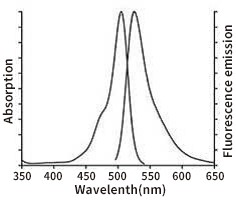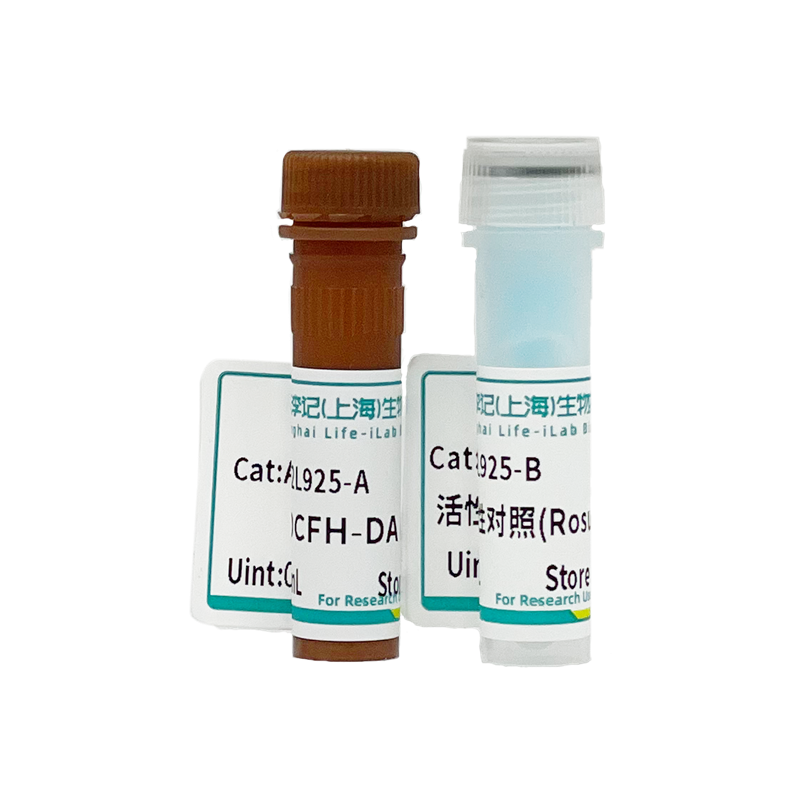Product Description
Reactive oxygen species (ROS) include superoxide radicals, hydrogen peroxide, and downstream products such as peroxides and hydroxylates, which participate in cell growth, proliferation, development, differentiation, aging, apoptosis, and many physiological and pathological processes. The Meilun Reactive Oxygen Species Assay Kit from Li Ji Biology is the most commonly used method for quantitatively detecting intracellular reactive oxygen species levels based on the fluorescence intensity changes of the fluorescent dye DCFH-DA (2,7-Dichlorodi-hydrofluorescein diacetate).
DCFH-DA itself does not have fluorescence and can freely pass through the cell membrane. After entering the cell, it can be hydrolyzed by intracellular esterases to generate DCFH. However, DCFH cannot penetrate the cell membrane, making it easy for the probe to be labeled inside the cell. In the presence of reactive oxygen species, DCFH is oxidized to produce the fluorescent substance DCF. The green fluorescence intensity is proportional to the level of reactive oxygen species in the cell, and detecting the fluorescence of DCF can determine the level of reactive oxygen species in the cell. At an excitation wavelength of 502 nm and an emission wavelength of 530 nm, DCF fluorescence was detected using fluorescence microscopy, laser confocal microscopy, fluorescence spectrophotometer, fluorescence enzyme-linked immunosorbent assay, flow cytometry, etc., in order to determine intracellular reactive oxygen species levels.
This reagent kit has low background, high sensitivity, wide linear range, and is easy to use. It can be used for the detection of various eukaryotic cultured cells, and provides Rosup, a positive control reagent for reactive oxygen species, which is convenient for the detection of reactive oxygen species. Based on the sample volume per well of a 96 well plate, this kit can be used for approximately 100 measurements.
ordering information
Product Name | Item number | Specifications |
Reactive oxygen species (ROS) detection kit | AC12L925 | 100T |
Product components
Components | Specifications |
A. DCFH-DA (10mM) | 0.1 mL |
B. Reactive oxygen species positive control(Rosup, 50mg/mL) | 1 mL |
Transportation and storage
Blue ice transportation- Store at 20 ℃ away from light, with a shelf life of 12 months.
usage method
1、 Loading probes
Cells with short stimulation time (usually within 2 hours): First load the probe, and then stimulate the cells with reactive oxygen species positive control or drugs of interest.
Cells with longer stimulation time (usually 6 hours or more): First, stimulate the cells with a positive control of reactive oxygen species or a drug of interest, and then load the probe.
1. In situ loading of probes (applicable only to adherent cells)
(1) Cell preparation: Perform cell plating the day before the test to ensure that the cell confluence reaches 50-70% during the test. [Note]: It is necessary to ensure that the cell state is healthy and not overgrowth during testing.
(2) Probe preparation: Dilute DCFH-DA with serum-free culture medium at a ratio of 1:1000 before loading the probe to a final concentration of 10 μ M.
(3) Probe loading: Remove the cell culture medium and add an appropriate volume of diluted DCFH-DA working solution. It is advisable to add a volume that can fully cover the cells, for example: a 6-well plate usually has no less than 1000 μ L; 96 well plates are usually not less than 100 μ L. Incubate at 37 ℃ in a dark incubator for 20-30 minutes.
(4) Cell cleaning: Wash cells three times with serum-free culture medium to thoroughly remove DCFH-DA that has not entered the cells.
(5) Drug induction: Add an appropriate amount of drug diluted to the working concentration in a suitable buffer or serum-free medium, and incubate in a 37 ℃ cell culture box in the dark. The specific induction time depends on the characteristics of the drug itself and the cell type.
(5) (Optional) Positive control: First, dilute the positive control (Rosup, 50mg/ml) with serum-free medium at a ratio of 1:1000 to a commonly used working concentration of 100 μ g/ml. Add cells and incubate at 37 ℃ in the dark for 20-30 minutes to significantly increase the level of reactive oxygen species, but there may be significant differences depending on the cell type. For example, HeLa cells are incubated for 30 minutes; MRC5 human embryonic fibroblasts 1.5 h)
2. Collect cells and load probes (applicable to adherent cells and suspended cells)
(1) Cell preparation: Cultivate cells according to standard methods and ensure that the cells used for testing are in a healthy state. Wash and collect sufficient cells using appropriate methods.
(2) Probe preparation: Before loading the probe, dilute DCFH-DA with serum-free culture medium at a ratio of 1:1000 to a final concentration of 10 μ M.
(3) Probe loading: After cell collection, suspend the cells in DCFH-DA working solution diluted to an appropriate volume, with a cell density of 1.0 × 106~2.0 × 107/mL. Incubate in a 37 ℃ cell culture box in the dark for 20-30 minutes, and mix thoroughly every 3-5 minutes to ensure full contact between the probe and the cells. 【 Note 】: Cell density needs to be adjusted according to the subsequent detection system, detection method, and total detection amount. For flow cytometry analysis, the number of cells detected in a single tube should not be less than 104, nor more than 106.
(4) Cell cleaning: Wash cells three times with serum-free culture medium to thoroughly remove DCFH-DA that has not entered the cells.
(5) Drug induction: Cells are suspended in a suitable buffer or serum-free medium diluted to the working concentration of the drug, or the cells are divided into several equal parts and stimulated with the drug. They are incubated in a 37 ℃ cell culture box in the dark, and the specific induction time is determined by the characteristics of the drug itself and the cell type.
(5) (Optional) Positive control: First, dilute the positive control (Rosup, 50mg/ml) with serum-free medium at a ratio of 1:1000 to a commonly used working concentration of 100 μ g/ml. Add cells and incubate at 37 ℃ in the dark for 20-30 minutes to significantly increase the level of reactive oxygen species, but there may be significant differences depending on the cell type. For example, HeLa cells are incubated for 30 minutes; MRC5 human embryonic fibroblasts 1.5 h)
2、 Testing
In situ loading probe method: direct observation with laser confocal microscope, or detection with fluorescence spectrophotometer, fluorescence enzyme-linked immunosorbent assay or flow cytometer after collecting cells.
Collect cells and load probes: detect with a fluorescence spectrophotometer, fluorescence enzyme-linked immunosorbent assay reader, or flow cytometer, or directly observe with a laser confocal microscope.
3、 Parameter settings
Use a 488 nm excitation wavelength and a 525 nm emission wavelength to detect the intensity of fluorescence before and after stimulation in real-time or at specific time points. The fluorescence spectrum of DCF is very similar to FITC, and DCF can be detected using the parameter settings of FITC. The excitation and emission spectra of DCF are shown in the following figure.

4、 Other matters explanation
1. The positive control Rosup is usually used in a ratio of 1:1000. Typically, a significant increase in reactive oxygen species levels can be observed 20-30 minutes after stimulation. The effect of reactive oxygen species positive control may vary significantly for different cells. If no increase in reactive oxygen species is observed within 30 minutes after stimulation, the induction time can be extended or the concentration of reactive oxygen species positive control can be appropriately increased. If the increase of reactive oxygen species is too fast, the induction time can be shortened or the concentration of reactive oxygen species positive control can be appropriately reduced.
For certain cells, if the fluorescence of non stimulated negative control cells is also relatively strong, DCFH-DA can be diluted at a ratio of 1:2000 to 1:5000, so that the concentration of DCFH-DA when loading the probe is 2-5 μ M. The loading time of the probe can also be adjusted appropriately within 15-60 minutes according to the situation.
3. Reactive oxygen species positive control (Rosup) is only used as a positive control sample and does not need to be added to every sample.
matters needing attention
1. This product is only for scientific experimental research and should not be used in clinical diagnosis, treatment, or other fields.
2. After loading the probe, be sure to wash away any remaining probes that have not entered the cell, otherwise it will cause a higher background.
After the probe is loaded and residual probes are cleaned, excitation wavelength scanning and emission wavelength scanning can be performed to confirm whether the loading condition of the probe is good. Please refer to the spectrum on the previous page for the excitation and emission spectra of DCF.
4. Try to shorten the time from probe loading to measurement (excluding stimulation time) as much as possible to reduce various possible errors.
This product is only for scientific experimental research and should not be used in clinical diagnosis, treatment, or other fields.














 Back
Back
 Back
Back





























